| Columns Retired Columns & Blogs |
Looks like the feet can get bent out of shape fairly easily!
Cheers George
I used DRA Labs' MLSSA system and a calibrated DPA 4006 microphone to measure the Nola Metro Grand Reference Gold's frequency response in the farfield, and an Earthworks QTC-40 for the nearfield and spatially averaged room responses. My estimate of the Nola's voltage sensitivity was 83.5dB(B)/2.83V/m, which is both low in absolute terms and significantly lower than the manufacturer's specification of 87dB. Despite a combination of 5.7 ohms and –45° phase angle at 87Hz, the Metro Grand's plot of impedance magnitude and electrical phase against frequency (fig.1) suggests that the speaker is a relatively easy load for an amplifier to drive. The magnitude drops below 6 ohms only between 90 and 300Hz, and the minimum value is 4 ohms at 122Hz.
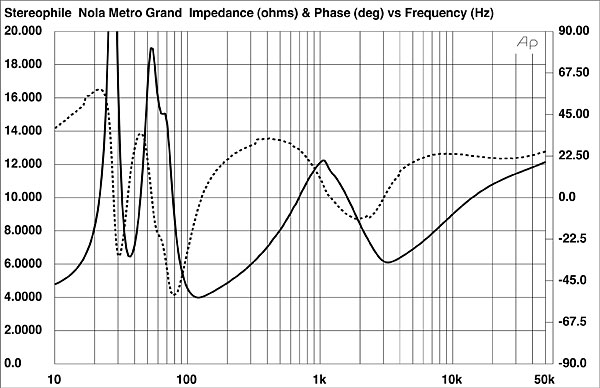
The impedance traces are free from the small midrange wrinkles that would imply the existence of cabinet vibrational modes. However, the "lid" above the open-baffle section is very lively, a waterfall plot calculated from the output of a plastic-tape accelerometer (fig.2) revealing several strong vibrational modes between 250 and 900Hz. The enclosure itself, which houses the two woofers, had a single strong mode present at 355Hz (fig.3), which could be detected on all surfaces other than the front baffle. Predicting the effect on a loudspeaker's sound quality from this behavior is difficult. However, I do suspect that it affected the coloration I noted on solo piano recordings. This coloration was slightly reduced with strategically placed mass damping (fig.4), though this cleaned up the accelerometer measurements only a little.


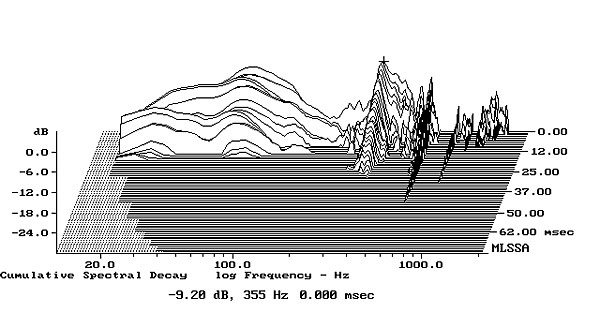
The Metro Grand Reference Gold's output at low frequencies is complicated, given that there is significant overlap between the midrange unit and the twin woofers, and that each woofer's reflex port is tuned independently. This is shown in fig.5, where each radiator's output, measured in the nearfield, is plotted in the ratio of the square root of the diaphragm's diameter. The midrange unit (black trace) extends for an octave below the nominal frequency where it is crossed over to the woofers. The upper woofer (blue trace) extends a little higher in frequency than the lower woofer (green), though both roll off with a shallow slope and contribute to the speaker's output in the midrange. The lower woofer has the usual minimum-motion notch in its output at 36Hz, the tuning frequency of the bottom port (purple). However, the upper woofer's low-frequency output features unusual double notches rather than a single notch, and the uppermost port (red) has two peaks rather than one.

The black trace below 300Hz in fig.6 is the complex sum (taking into account acoustic phase and the different distance of each radiator from a nominal farfield point) of these nearfield responses. With the overlap between the radiators and the inevitable boost from the nearfield measurement technique, which assumes a 2pi, hemispherical acoustic environment rather than the actual 4pi, spherical one, this graph shows a large peak in the mid- and upper bass. To some extent, this will be an artifact of the measurement, but farfield measurements do suggest that the Nola speaker's low frequencies appear to be about 3dB higher in level than the midrange.
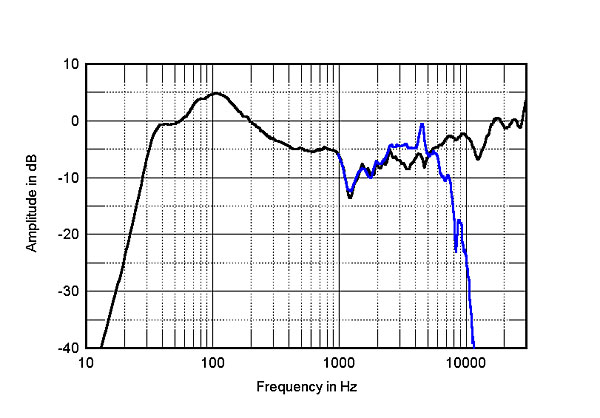
The blue trace plotted above 1kHz in fig.6 is the speaker's farfield response, taken on the ribbon tweeter's axis but with the tweeter disconnected. The midrange unit peaks sharply at 4.35kHz before rolling off with a very steep slope. Adding the tweeter (black trace) extends the high-frequency response to the 30kHz limit of this graph, but reduces the level between 2.5 and 5kHz, suggesting that the two units are actually out of phase in this octave. The significant lack of energy between 1 and 2.5kHz would explain both the measured lack of sensitivity and, all things being equal, the polite balance I noted in my listening.
Toward the end of the review period, Carl Marchisotto let me know that the axis he intends the Metro Grand Reference to be measured on is not the tweeter axis, but midway between the tweeter and the midrange unit. I therefore examined how the speaker's response varied on the two axes, even though, now that the speakers were back in my listening room, I had to use a closer microphone distance: 24" rather than my usual 50". The blue and red traces in fig.7 respectively show the responses of the left and right speakers at this close distance: The low-treble suckout has moved higher in frequency, but has deepened. The green and purple traces show the left and right responses on the axis recommended by Marchisotto: There is now no suckout, and the responses of both speakers are smoother throughout the treble.

However, I could change the measured response by moving the microphone an inch in any direction. Also, as Marchisotto had set up the Metro Grand References in my room with the midrange units on the outside edges of the speakers, the recommended axis is not pointing toward the listener. I therefore took the response of each speaker at the listening position, 98" away (fig.8). (To minimize room effects at this distance, I had to drastically window the measured impulse response; hence, I have plotted the responses only above 400Hz.) The picture has changed again. Though there is now a suckout centered on 2kHz, the treble is otherwise fairly smooth, if on average about 3dB below the level in the midrange.

Fig.9 shows the Metro Grand's lateral dispersion, normalized to the response on the tweeter axis, with the off-axis behavior on the midrange side of the baffle shown to the rear of the graph. With the open-baffle environment for the midrange and tweeter and the lateral arrangement of the drive-units, this graph is difficult to interpret. Basically, however, despite Marchisotto's setting up the speakers to fire straight ahead, it suggests that the Nola's balance can be changed by experimenting with toe-in. As there is more treble energy apparent off-axis on the midrange side, the sidewalls need to be damped. In the vertical plane (fig.10), there will be more mid-treble energy when you sit below the tweeter axis, which is a high 45" from the floor with the speakers sitting on their bases.


The Nola's spatially averaged plot (red trace) in fig.11 shows how this behavior adds up in the listening room; the blue trace is the spatially averaged response of the Triangle Signature Delta, taken under identical conditions when I reviewed it for the September issue. The Nola's trace is actually very smooth from the lower midrange up, though significantly less energy is apparent in the top three octaves than with the French speaker. The Metro Grand has more output in the low midrange and bass, though this is disturbed by the usual lack of energy in the 40–80Hz octave, a room effect that has not been ameliorated by the spatial averaging.

In the time domain, the Nola's step response on the tweeter axis (fig.12) shows that its tweeter and woofers are connected in positive acoustic polarity, the midrange unit in inverted polarity. The output of the tweeter arrives a little too soon on this axis for an optimal blend with the negative-going start of the midrange unit's step, meaning that Carl Marchisotto's advice about the best axis on which to measure the Metro Grand Reference is correct. What would be a clean decay throughout the treble in the speaker's cumulative spectral-decay plot (fig.13) is disturbed by a ridge of resonant energy at 4.35kHz, the frequency of the peak in the midrange unit's response. It is fair to note, however, that other than a slight accentuation of sibilants, I didn't hear the effect of this resonance.
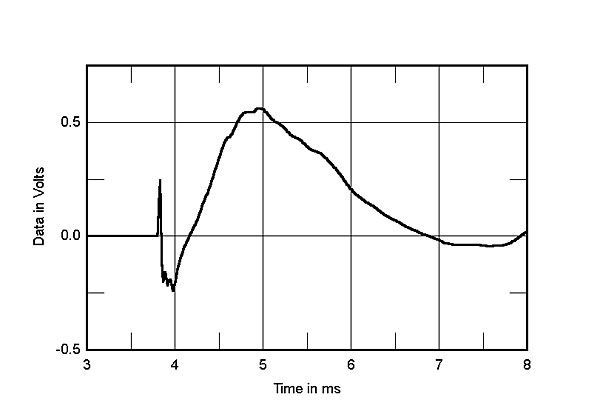
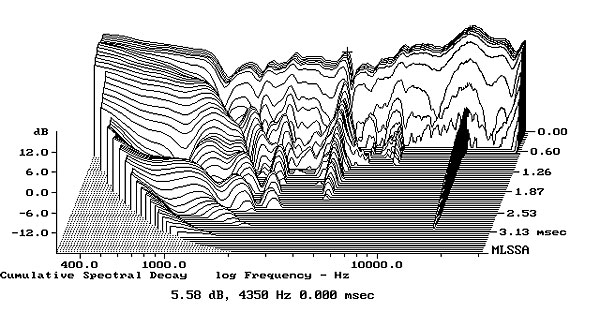
Overall, the broad overlap between the drive-units' outputs and their spatial disposition made it very difficult to get a handle on the Nola Metro Grand Reference Gold's measured performance.—John Atkinson

Looks like the feet can get bent out of shape fairly easily!
Cheers George

I really appreciate the honesty and clarity of JA's reviews. Having met him a few times at CES, he is a remarkably nice person - and clearly a sound technologist (no pun intended). But this review, although accurate in terms of observed limitations, doesn't fully convey how tremendous these speakers are in day-to-day listening. These, and the Nola Micro Grand Reference, are among the best loudspeakers I've heard to date. It seems that manufacturers have to make choices in terms of how their products ultimately sound, while knowing they may not meet what are normally valid performance standards (vibration, ultimate treble extension, etc.). I have listened at length to the usual suspects, and although I don't have JA's years of experience in this arena, I can say it all comes down to subjective preference and system synergy. Given my own experience, these speakers are simply astonishing in terms of what they convey musically.

Looks like the feet can get bent out of shape fairly easily!
Pretty sure that's a photographic distortion. The review samples had feet that were super-straight.
John Atkinson
Editor, Stereophile

$33,000 per pair sounds expensive for speakers that do not play loud or have good clarity in the midrange. for 1/3 the price one could have a pair of Klipshorns and a small tube amp and you will have both volume and Clarity.

I'm curious. Where is the cutoff for Audacious Audio? Has it changed over time?

Where is the cutoff for Audacious Audio?
Basically, any product with a price significantly higher than that of the typical price for that category qualifies for the "Audacious" label.
John Atkinson
Editor, Stereophile

That's a bit of hyperbole, isn't it? They're quite lovely in person, and I would know, thanks. And to call the IRS "ugly"?? Can't fathom your idea of beauty…
Moving along, Mr. A's review is fascinating, given The Absolute Sound's review of the speakers several years ago, in which they hardly sounded "polite." I don't doubt Mr. A's hearing at all. I suspect a change in drivers from back then. I heard the speakers years ago, and the sonics were different, which I attributed to different equipment. Now? I don't think so. A friend had older Boxers and compared them - in his room - to another friend's newer Boxers. Sound was different, mainly in the treble, which did not expand dynamically on the newer ones. The newer ones sounded less real than the older ones. His dealer thought the same thing, but hey, you sell what you got, right? Something's changed over time. Not that unusual: the Pipedreams are also said to have sounded different from one pair to the next, as noted in TAS. Maybe it's a capacitor, who knows? But those Boxers? No question they were more cousins that identical twins. Heard that about the next speaker up in the line, too. I wonder why a company does that?